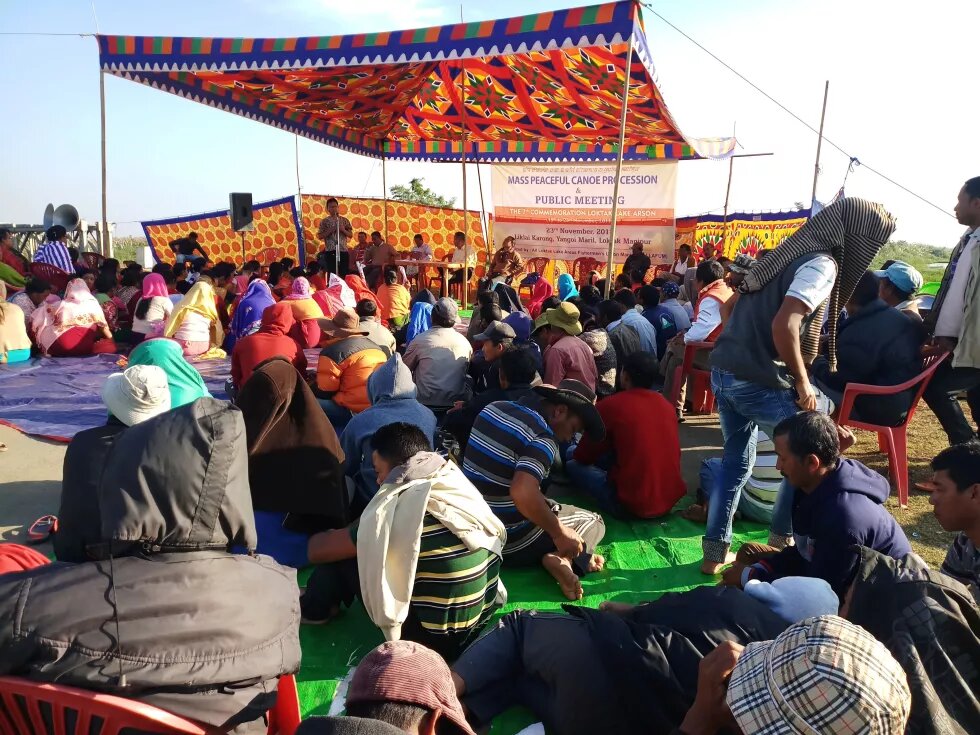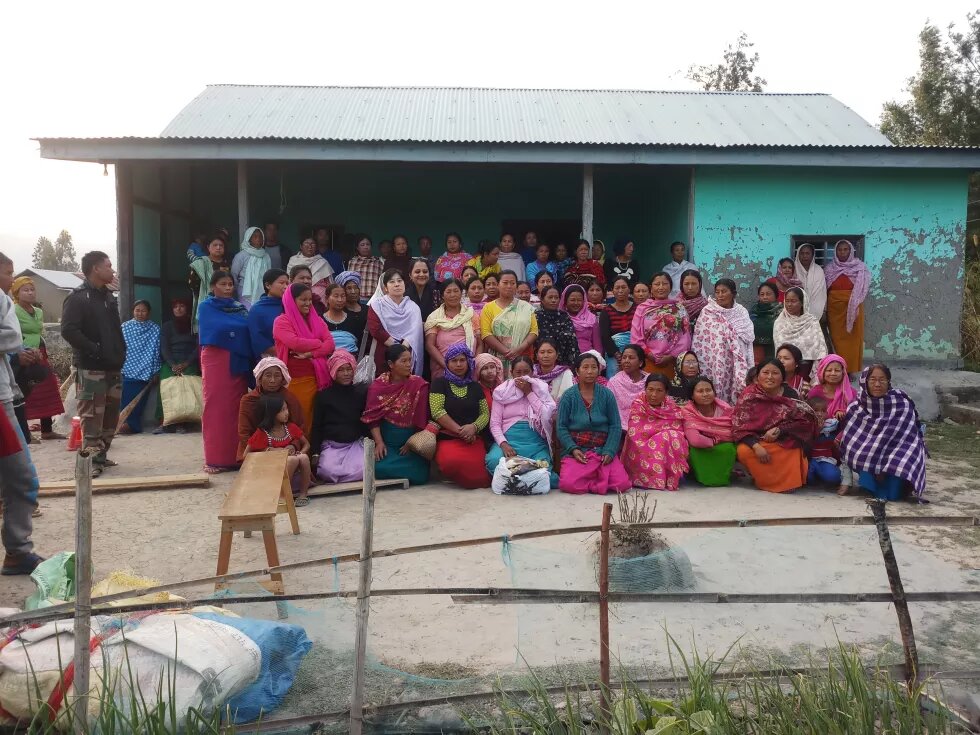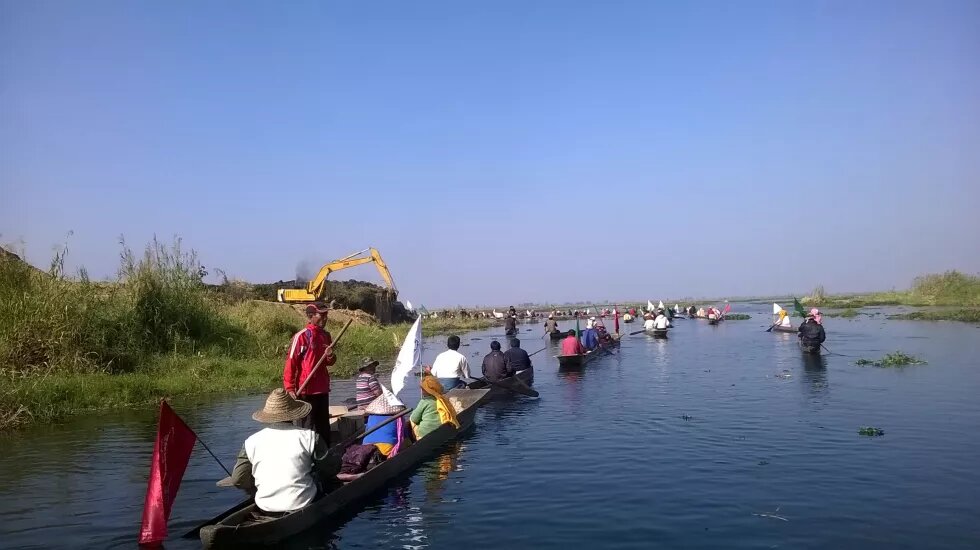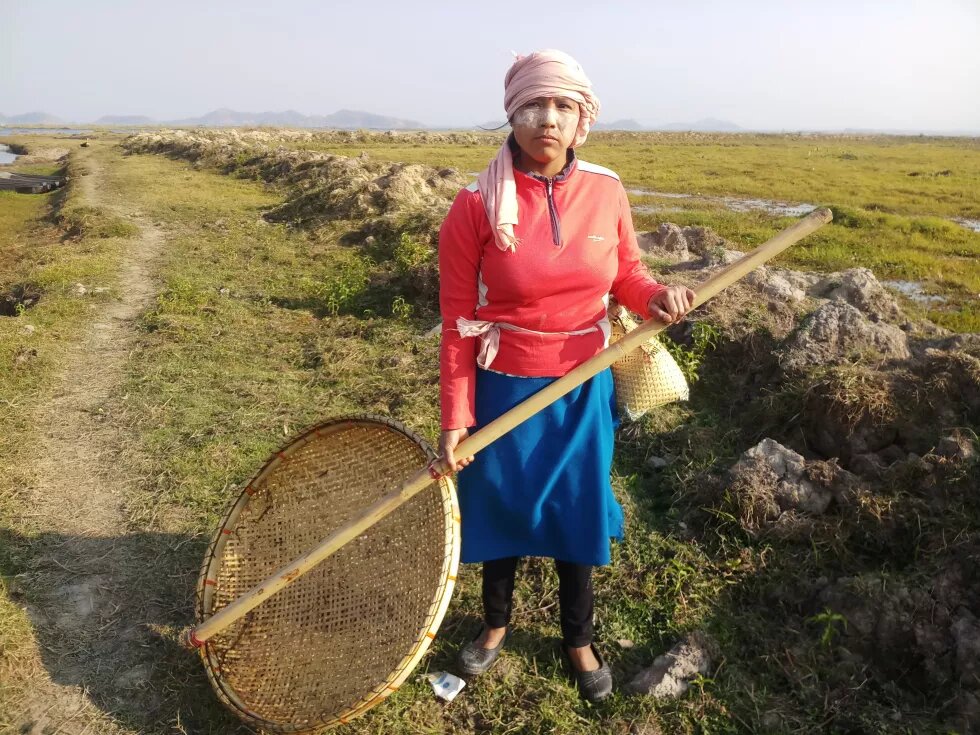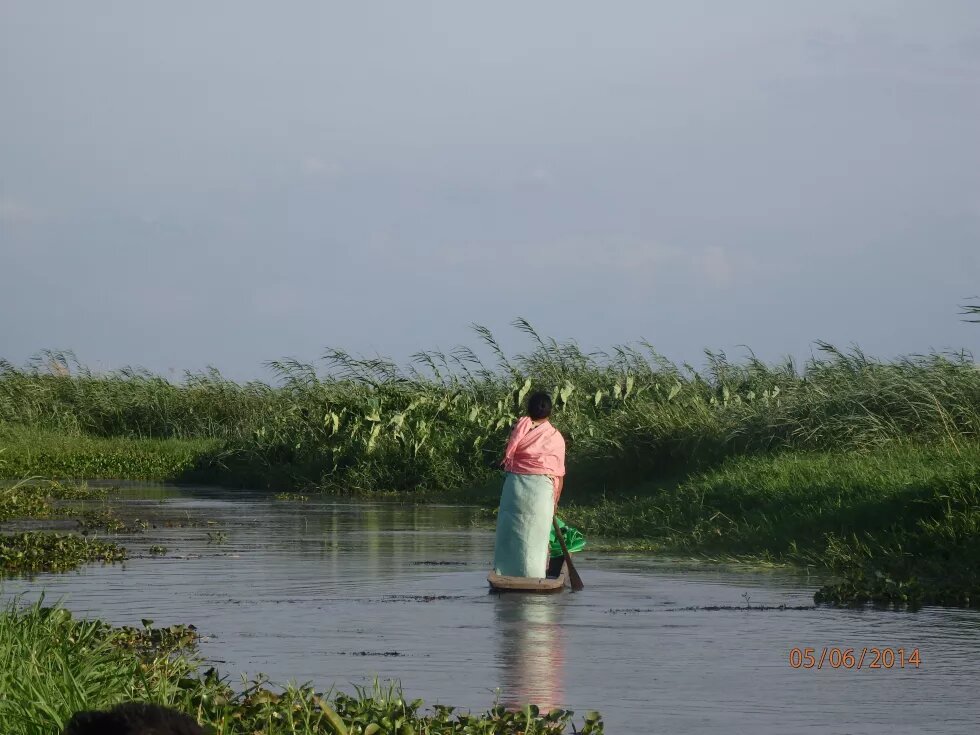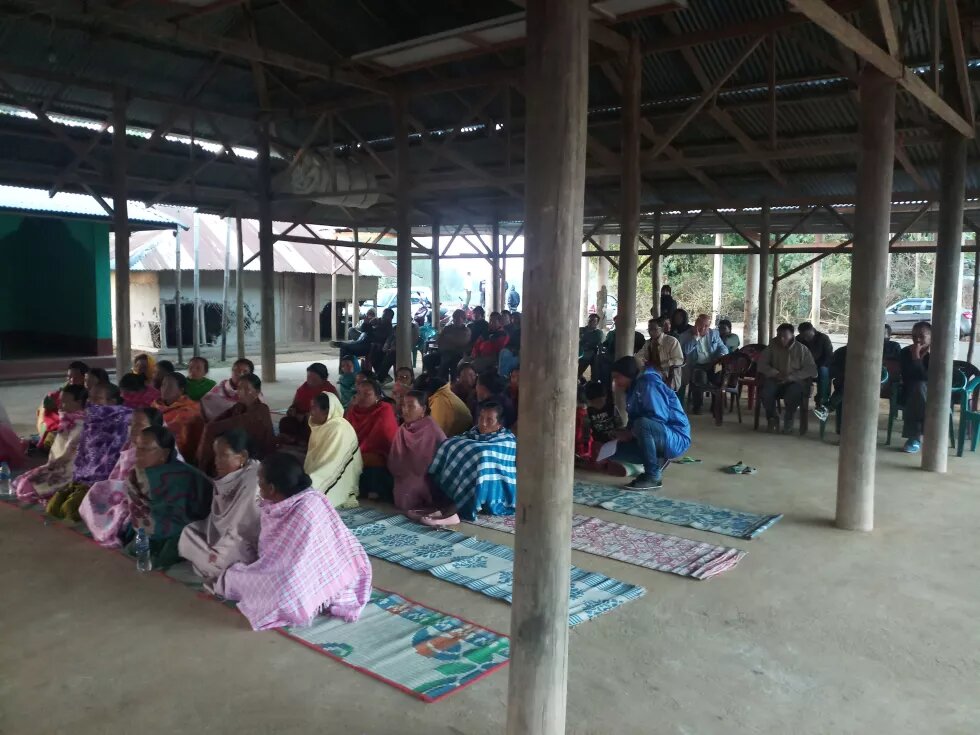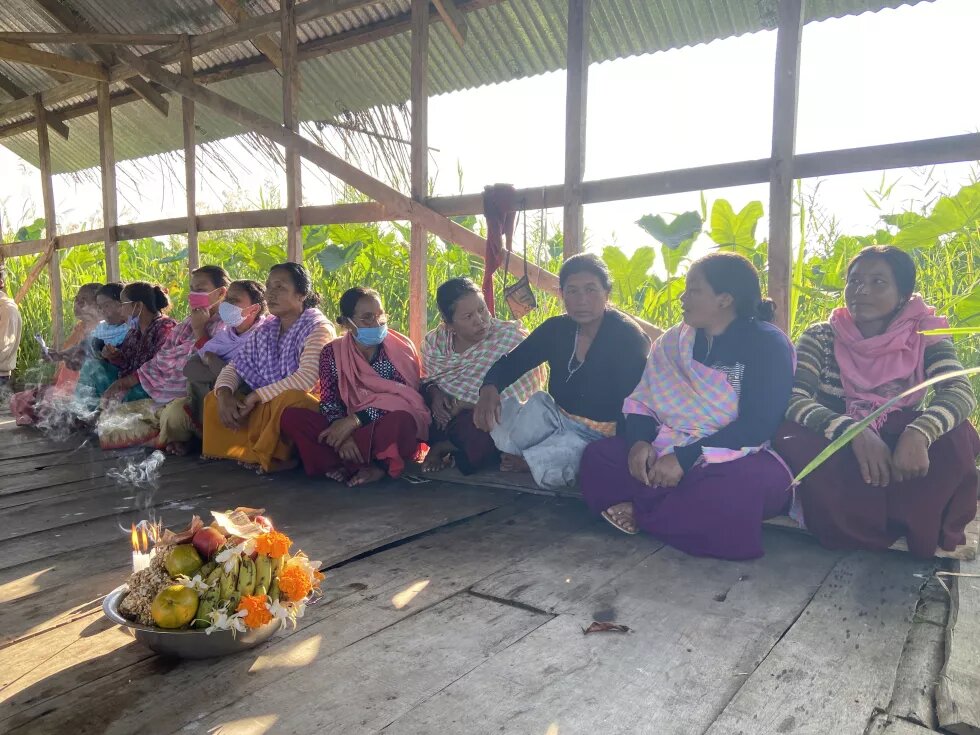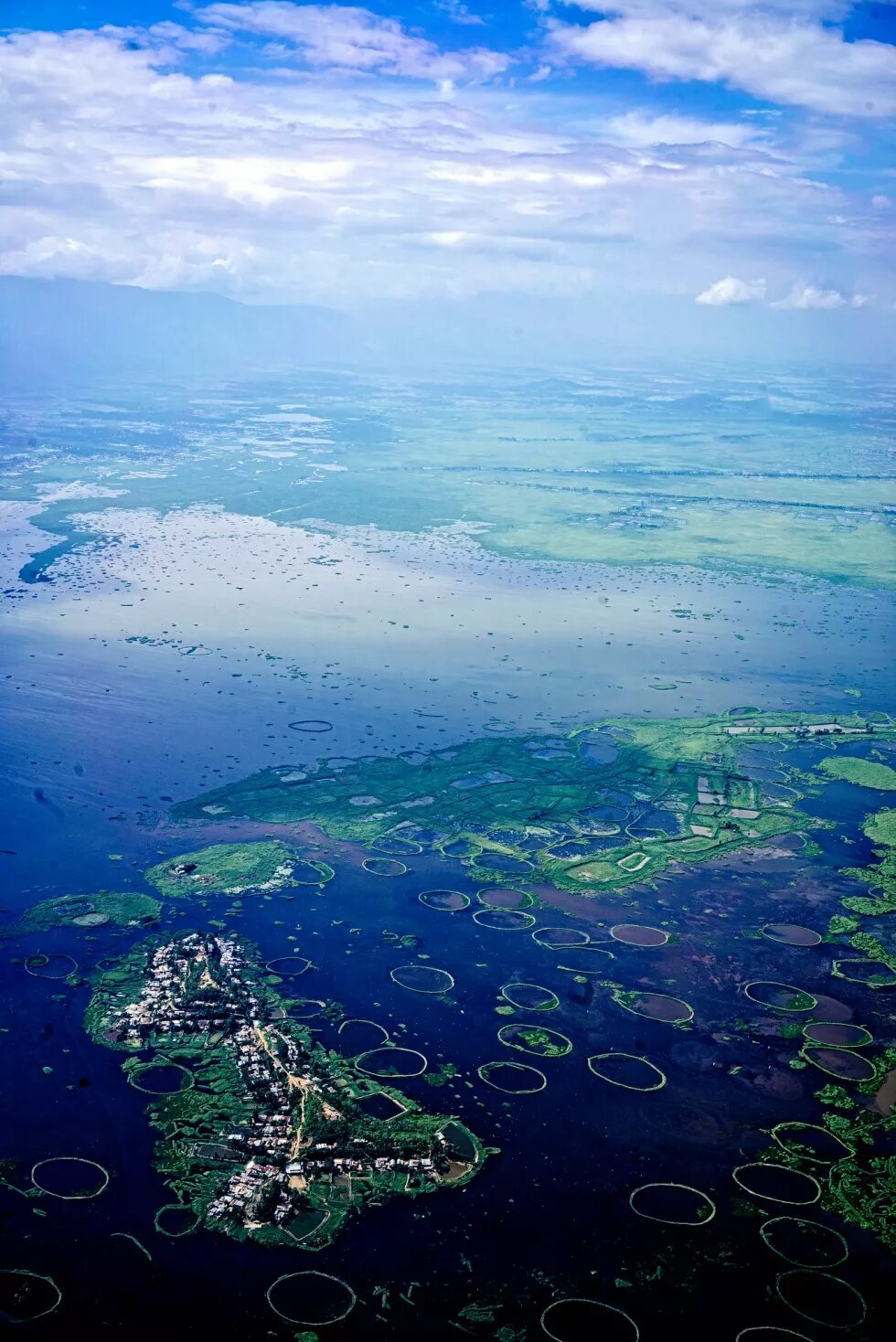
Fisherwomen of Manipur continue resistance against aggressive lopsided projects in a pulsating lake revered as ‘mother’ and listed as a Ramsar site.
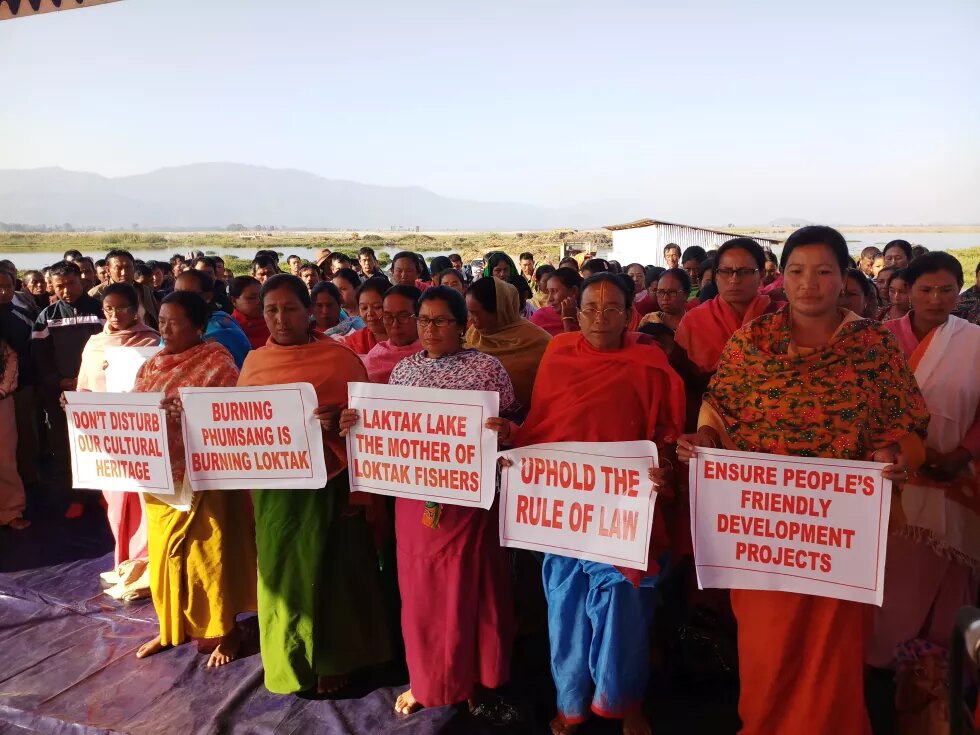
Nature nurtures the mankind. However, when mankind tries to fiddle with nature, it faces the wrath of the latter. Loktak Lake in the state of Manipur is a glaring example of how human intervention can damage a natural setting and also adversely affect those depending on it. Loktak, measuring about 235 square kilometres, is the largest freshwater lake in Northeast India. The lake has within it the only floating national park and the natural floating village in the world. It is also home to thousands of fisherfolks.
Ask anyone living in and around Loktak Lake what it means to him or her.
“Loktak Ema[i] is our provider” will be the reply and it will have its echoes loud and clear across the vast expanse of the lake.
Loktak Lake is situated in the state of Manipur. Measuring about 235 square kilometres, Loktak is the largest freshwater lake in Northeast India. The lake has within it the only floating national park and the natural floating village in the world. It is also home to thousands of fisherfolks.
Since centuries, through generations, many have depended, and shall continue to depend, on the lake. It not only provides food and shelter to hundreds of families living in the peripheral shores but also shelters many species of fish, aquatic plants, endangered mammals and migratory birds. It provides sources of livelihood for thousands of people directly or indirectly dependent on its aquatic resources. It plays an important role in making the valley fertile and productive. The lake is the foundation of several legends, myths and historical events that provides insights into ancient Manipur.
A visit to Loktak, a listed Ramsar site, is a must on the itinerary of any visitor to Manipur; many from the state itself too long to have a glimpse of the lake from any of its peripheral locations. These visits, seemingly unwarranted, are proving to be a systemic bane rather than a boon for Loktak as well as for the people living in and around it. For the very reason of these visits, each and every ruling government has tried to flex its muscles by pushing a series of tourism related projects to give a boost to tourism, supposedly the only viable industry in the conflict torn state – all at the cost of Loktak.
Understanding the lake requires going back to history prior to the construction of Ithai Barrage, where there were patches of water bodies, which during monsoon became one body called Loktak. These smaller bodies of water were separate lakes with separate names. They were named according to certain ‘owners’ based on first use of clans or sub-clans or by the area or some kind of landmark. Only those who reside there now know by these separate names or else it is one just big lake, Loktak. The current development politics of Loktak can be broadly be asserted as those who know the many parts of Loktak versus those who know only one vast Loktak.
“We are the user and protector of the lake and should be the ‘owner’ of the lake. But the government has been taking up projects in the lake without the consent of the Nga-mees.”
(Note on interviews is at the end of the article)
Therein lies the problem of contestation of ownership as the state, according to the Manipur Loktak Lake (Protection) Act, 2006, is the state authority through Loktak Development Authority (LDA) to administer and manage the lake. LDA was constituted in 1986 and reconstituted by the Act to look after the management and conservation of the lake, where understandably the committee is dominated by government officials and with little or no participation of local stakeholders.
The Act defines the traditional dwellers of the lake as ‘occupiers’, which is in clear contradiction to the Ramsar Convention’s Resolution VII(8) that gives room for recognition of stakeholders. The Act is in contravention to the National Wetlands Rules of 2017 as well where crucial “Wise Use” principle is not even mentioned once. The Act itself, moreover, is in clear violation of the statutes given in the United Nations Declaration of the Rights of Indigenous Peoples, which recognises indigenous peoples who have been living in harmony with the lake for centuries as its guardians and beneficiaries. The lake people are now being defined as occupiers and encroachers.
The contest for ownership
As a follow up to the enactment of the Act of 2006, Loktak Development Authority (LDA) officials entered into the lake area along with police during mid November 2011. From 15 November to the 25 November, it launched an eviction drive wherein several huts built on the floating biomass phumdi[ii] were dismantled and burnt to ashes. Around 777 out of 1,147 phum-huts[iii] inhabited by around 10,000 people within the lake were forcibly evicted by during this period.
“We tried to talk with the officials calmly, but they didn’t listen to us. We thought that those in uniform would at least show some decency but no they didn’t. They treated us like mosquitoes and flies”.
“We saw the Watermaster and I told them, let us climb the machine. So, we went to climb it and I almost reached the top. They tried tickling my foot but I kicked them, some in the face. They could not stop me. If I was on the machine then they won’t dare destroy the khangpoks (phum-huts) or if they dared I would have died but I was ready to sacrifice my life to save Loktak Ema. I came down when people started rushing and lowered the machine.”
“Then when they started chopping the khangpoks with swords, a team led by the secretary of All Loktak Lake Fishermens Union, Manipur tried to commit suicide. They laid themselves down in the phumdis and shouted out to first shovel-dig in their body before destroying the khangpoks.”
Despite strong protests by the fishers, the LDA went ahead with the eviction and 14 more phum-huts were destroyed in January 2012 without any prior notice. Between 8 March 2012 and 29 March 2013, it destroyed 56 more phum-huts in contravention to a high court order of 25 January 2012 staying the eviction. On 16 February 2013 a contempt notice was issued against the LDA for violating the court orders. However, it attempted another arbitrary effort at eviction again on 29 March 2013.
Then came the lull – no activities for almost a decade from the government side. It is during this period that the fishing families worked to strengthen themselves under the All Loktak Lake Areas Fishermen’s Union, Manipur (ALLAFUM). The main leaders are men but ALLAFUM drew its strength from the women who wore the spirit of resistance. ALLAFUM’s solid organisation is reflected in the fact that no one, including the government, dares to bring their motor boats to the centre of the lake. The ALLAFUM members will fiercely oppose any such move as motor boats cut and destroy the fishing nets. The organisation went to court and till date LDA has not been able to abide by the court’s order where it has been directed to conduct a joint survey of the fishing families living on floating huts.
Even though LDA was not able to operate inside the lake as earlier, it was continuing to push projects along the periphery of the lake. A small hillock by the name of Sendra was leased away for a resort while a road from Mayang Imphal to Toubul was metalled dissecting almost one-fourth of the lake. LDA was also planning a ring road around the lake. Often, ALLAFUM members, especially women, resisted such projects.
Current resistances
In the current scenario, renewed and serious attempts are being made by the government to stake claim over the lake, which is considered to be against the way the lake and its people complement each other. We will look primarily at two issues and reflect on how the fishing women and the villages responded to these proposals from the government.
On 3 January 2018, the state government’s forest department notified through local dailies of their intention to convert the Loktak lakefront of Thinungei village into a bird sanctuary. Thinungei is one of the fishing villages on the western lakeshore. Migratory birds[iv] from around the globe visit Loktak in winter every year in large numbers but they flock to many locations across the lake and not just Thinungei. So the government notification to confine the bird sanctuary only to Thinungei came as a surprise.
An RTI query filed by Indigenous Perspectives[v] revealed that there were no scientific background studies, document and data that could be a base for notifying Thinungei as a bird sanctuary[vi]. The massive protests in response to the notification seem to have forced the government to lie low, at least for the time being.
Here are some quotes from women of Thinungei that reflects the mood.
“When we heard about the Thinungei Bird Sanctuary, we panicked. Prohibiting us from entering the lake and only reserving a space for the birds is meant to cut off the source of our livelihood and it is a case of gross violation of human rights. No discussion was held with the villagers before notifying it as a bird sanctuary.”
“With the government being adamant on its proposal without any discussion with the villagers and the villagers aspiring to be included in the planning process, the rift grew larger. Subsequently, the officials who came to survey were barred from entering the area by the people, with the women in the forefront. The fishing communities of Thinungei had several rounds of meetings amongst themselves to discuss their strategy.”
“We were not afraid of even those in uniform having guns, tear gas or sticks. They said, ‘Nongmei amuk kappada, ki dana chen-khradabane’ (a single shot and the crowd will disperse). So, we told them ‘Noina ngammaga hatlu laklo, eikhoi ngamma-ga noi hatkani’ (kill us if you can. But if you can’t, we will kill you)”.
It was a do or die situation for the villagers. The government offered no alternative source of livelihood except providing a job to one member from each household, which meant security for a generation only. However, submission to such an offer raises the question of how the next generation will survive, while Loktak has been sustaining generations. Other alternatives like duck farming, piggery, poultry and textiles were also cited but that came with high risk in the market with higher investments. The meagre sum of compensation people were offered would dry up within months. On the other side, women and men who all depended on fishing were to be badly affected if the bird sanctuary came up. So they resisted. Women barricaded the road by hanging out their phaneks[vii]. They came out in large numbers and took the lead in the rallies and protests that ensued. At least, 10 persons were seriously injured, all women. Unsurprisingly, only one man was injured in the protest.
Here I would like to highlight the critical question of the model of conservations where western model[viii] does exclude people or keeps them in the margin to the extent of categorising them as ‘occupiers’ or ‘encroachers’. We see this play out at Keibul Lamjao National Park[ix] where people are completely excluded from the conservation of Sangai. What we see in the Loktak Protection Act of 2006 is a replica of a typical western conservation model where the law seeks to remove any human activities in the core zone of the lake.
The proposed bird sanctuary at Thinungei is a reflection of the same thinking. However, the intricate relationship between people and nature will fall apart if this model of conservation gets implanted. When I enquired further, local people argued that they had always lived with the migratory birds and knew which species of birds occupied which particular parts of the lake and what they fed on. They argued that the whole lake must be a bird sanctuary rather than just their village and that the local fishing villages and those who lived in the middle of the lake in floating huts must be made the guardians of these migratory birds rather than the current model of the government where people would be excluded in the efforts to protect the birds.
I must also quickly mention another project that will have long term consequences and which has been highly contested by local fishing groups. The Loktak Inland Waterways Improvement Project was suddenly in the news when the Press Information Bureau (PIB) of the central government announced on 28 November 2019 that this project had been sanctioned Rs.25.6 crore. The project plans to connect three islands and seven villages in and around the lake by motor boats. This project has met with resistance from all the fishing villages. They have now come together under one umbrella body known as Ngamee Lup (the fishing federation) to oppose it. Ngamee Lup is now an informal body formed by executive members of different fishing unions and associations and this is for the first time an apex body of fishers of the valley of Manipur has come up to identify and protect the rights of fishers as part of the joint resistance against the Loktak waterway project. Fishing associations of Ningthoukhong, Thinungei, Thanga and Champu Khangpok have made separate submission to the grievance committee of the Manipur State Wetlands Authority asking the government to drop the project as it may destroy the lake ecosystem, which, in turn, may destroy the livelihood of the fishing community. They say the dugout canoes or non-motorised boats are lake-friendly while a motor boat is noisy and can spoil the water with the use of oil, destroy fishing nets, disturb birds and numerous seen and unseen aquatic life. A critique of the waterways was prepared by ALLAFUM along with other supporting organisations and was also submitted to the government[x].
Standing up for Loktak
Based on the above information and broad movement of the fishing unions of Loktak, I would like to analyse the role and contributions of women in resisting laws and projects that not only adversely affect Loktak’s ecology but also undermine their own livelihoods and existence.
In Loktak, fishing is a way of life; in fact, fishing is life. This is true for many other wetland areas also. Besides, catches from capture fisheries comprise the main source of protein for the inhabitants. Among the Meitei indigenous people, who are primarily settled in the small Manipur valley area, in every meal you will eat fish, whether in fried, dried, smoked, fermented or fresh in the dishes. Fishery in Loktak Lake accounted for up to 60 per cent of the total fish production in the state[xi] but this has reduced drastically due to several reasons such as the impact of the barrage and declining water quality.
Loktak is the primary source for fish, the staple diet of Manipur, as dependence on the riverine system is seasonal. More than 100,000 people directly or indirectly depend on this ecosystem for their food and livelihood. Over the decades, however, the Ithai Barrage has altered the hydrology and ecology of the Loktak wetland, while continuing to pose threats to the food security of the indigenous community. Nevertheless, women across the breadth and length of the lake persevere to feed their families and make ends meet through the year. It is poignant here to mention that most of the families are indebted with high interest rates borrowed from local moneylenders and at the onset of the COVID-19 pandemic in 2020, they appealed to the government to give relief as the lockdown affected their sales. However, there was no response from the government.
“Here in the lake, we women don’t wait for the men. We do what we can. We can do almost what the men do. We look after our families, help each other out in spreading the nets and catching fishes. A husband doesn’t usually fish alone so division of labour is equitable.”
Livelihood activities along with fishing in Loktak Lake are largely a women’s domain. They play multiple roles – from catching to processing to transportation to marketing. During the season when fish are available in abundance, women spend several nights working to preserve them in various forms for use during off-season. Although men do assist in larger scale operations, which do not happen regularly, in general women independently undertake the smaller scale activities such as laying fish nets, drying of fish and then taking them to the market. Fish marketing is generally undertaken by women and is an exclusive domain of women in retail trade sector[xii]. It is the fisherwomen who also supply the unique edible aquatic vegetation of the lake to the larger markets as their work is not limited to only catching fish. And Loktak provides immensely.
As women are involved with fish trading for the major part of the day, they are hard pressed for time to accomplish other activities. Women face enormous problem in the transportation of fish in the early hours of the day. The most difficult problem is rowing a boat and catching a public transport to the market in the wee hours and that of frequent strikes by different groups, which result in loss of several days a month. With no cold storage facilities in place women face hardship in preserving the fish that are not sold. A common means of preserving fish is to smoke it. No man ever smokes fish; it’s the women who do this tedious task with possible health hazards of overexposure to smoke.
Women have been visible in every form of protest and dissent in Manipur for the past decades and Loktak is yet another theatre. The state has consistently responded with violence and repression. In certain cases, where persons of influence or projects with high economic returns like tourism were involved, the police would come out in force and resort to teargas firing and baton charge. There is very little formal documentation of this form of extensive state condoned or perpetrated violence against women. The women who were injured during the protests might heal physically but the trauma remained. There is also angst of the uncertainties of their very survival and means of livelihood in the future. When ten women were seriously injured in brutality unleashed by the Manipur police sans any women police personnel at Thanga Chingjin for protesting against the Act on 19 December 2011, it effectively created shock and panic amongst the villagers for many years to come.
But then, when it comes to any forms of resistance, women have led from the front when the forces in uniform arrive to back officials implementing government order. This is because when a man tries to speak or even resist, those in uniform usually beat him up. In worst cases, they do not hesitate to fire upon men. Besides, in Manipur it is quite easy for the police to accuse men who resist any development project of having links with the underground militant groups. So, in most cases women lead from the front but that does not mean that men lag behind. The shared understanding of the need to protect the lake is the key to their active participation in the space as a collective, no questions asked, no seconds lost in dire circumstances, it is personal and so it is political.
“If the government comes back to Loktak with projects that will destroy the lake we will resist and resist, and we are ready to even go further than what happened in the Kangla nude protest or on June 18.”
These are indigenous women who rely on nature and primary resources (here Loktak) for their survival as well as for their spiritual and cultural grounding, and they continually find themselves directly threatened by the proposed projects while trying to survive through the poverty manufactured primarily by Ithai Barrage[xiii]. In most regions, women are already central stakeholders – in farming, water and resource management, and household consumption decisions – making them uniquely poised to chart a new social, economic, environmental, and political course[xiv]. It is time for the policymakers to try not to ‘nurture’ nature but to harmoniously work towards and for a sustainable future. While there is an increasing consciousness of the relationship between women and nature globally, the women of Loktak continuously reaffirm these convictions.
Loktak is regarded as Ema and it is the female spirit and power that has transcended over the centuries providing sufficiently to those dependent on it. It is also the intimate knowledge of the lake by the fishing community, which has enabled them to protect Ema with all their candour. Violating Loktak Ema is an attack on womenhood and the fishing women of Loktak shall not absolve any perpetrators and shall retain their resilience and fight for the regeneration and sustenance of Loktak Ema.
Women interviewed from end October 2020 till 14 November 2020.
Champu Khangpok floating village:-
Ema Ekashini (53) was the one who climbed the Watermaster to stop the destruction of the floating huts
Ema Sanajaobi (55) and Ema Chaoba(54) Ema Thasana(48)
Thinungei:-
Ema Memma and Ema Sorokhaibam Joybati Leima (58)
Ningthoukhong:
A group of women were interviewed in a focus group discussion and names have not been given as such as the output were rather general.
ENDNOTES
[i] Ema is ‘mother’ in Manipuri, and people in general, those who live on the lake as well as those depend on it refer to Loktak as Loktak Ema.
[ii] Floating islands made of soil, organic debris, and matted vegetation that are in various stages of decomposition
[iii] Huts on the floating islands
[v] Indigenous Perspectives is an NGO based in Imphal that focuses on local and indigenous issues. This author is associated with it since its inception.
[vi] Indigenous Perspectives filed an RTI on 21 January 2019 and the response from the office of the principal chief conservator of forest/ wildlife and chief wildlife warden came on 7 February 2019.
According to response No. 2 of the RTI, the Government of Manipur has not prepared any detailed project report (DPR) nor any background documents on the proposed sanctuary. It simply says that “….it is the prerogative of the state government in accordance with the powers …. Under section 18 of the Wildlife (Protection) Act, 1972 … to declare its intention to constitute any area as a sanctuary if it considers that such area is of adequate ecological, faunal, floral, geo-morphological, natural or zoological significance, for the purpose of protecting, propagating or developing wildlife or its environment”. However, under the same RTI response No. 5, it says that there is no specific bird estimation done for any specific location including that of Thinungei though the forest department has bird census data from 2011 till 2018. Strangely and in contradiction to saying that there is no location specific data, the same response No. 5 claims that Thinungei is the area with maximum density and species diversity!
In other words, there are no scientific background studies nor any document nor any data that can inform a decision to announce a notification for TBS. It is at best an arbitrary decision of the department and therefore the notification has no standing and has to be annulled until adequate information is gathered.
[vii] Traditional sarong worn by women
[viii] The term ‘western model’ here is used in the sense as used by authors such as Ramachandra Guha who explained in several papers on varieties of environmentalism about western or northern conservation models where people are kept out of an effort to protect a specie. He goes on to say that in the south people have lived with animals. When conservation sans people is ‘imported’, they tend to create several problems with local communities.
[ix] Keibul Lamjao National Park (KLNP) is a 1977 declared national park of 40 sq km within Loktak Lake. People who were dependent on this wetlands were deemed encroachers. There has been intermittent conflict of people with park officials since then. Loktak is a fine example how different conservation models have been played out.
[xi] Loktak. Newsletter of Loktak Development Authority. Vol. March 2003-Vol.3.
[xii] Nupi Keithels or women markets dots all over the valley of Manipur and these are markets where only women are allowed to sell. The central market of all these women markets is the Nupi Keithel situated in Imphal, the capital of Manipur.
[xiii] To understand the impact of this barrage please refer to http://www.e-pao.net/epSubPageExtractor.asp?src=education.Scientific_Papers.Ecological_social_impacts_of_Ithai_Barrage_Part_1_By_Ramananda_Wangkheirakpam
[xiv] https://www.opendemocracy.net/en/5050/mapping-womens-resistance-to-social-and-ecological-degradation/
Disclaimer:
This article was prepared with the support of the Heinrich Böll Stiftung. The views and analysis contained in the publication are those of the author and do not necessarily represent the views of the foundation. Heinrich Böll Stiftung will be excluded from any liability claims against copyright breaches, graphics, photographs/images, sound document and texts used in this publication. The author is solely responsible for the correctness, completeness and for the quality of information provided.

